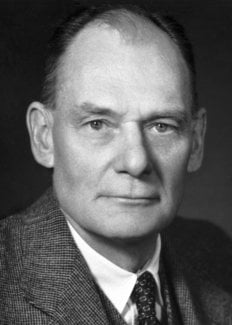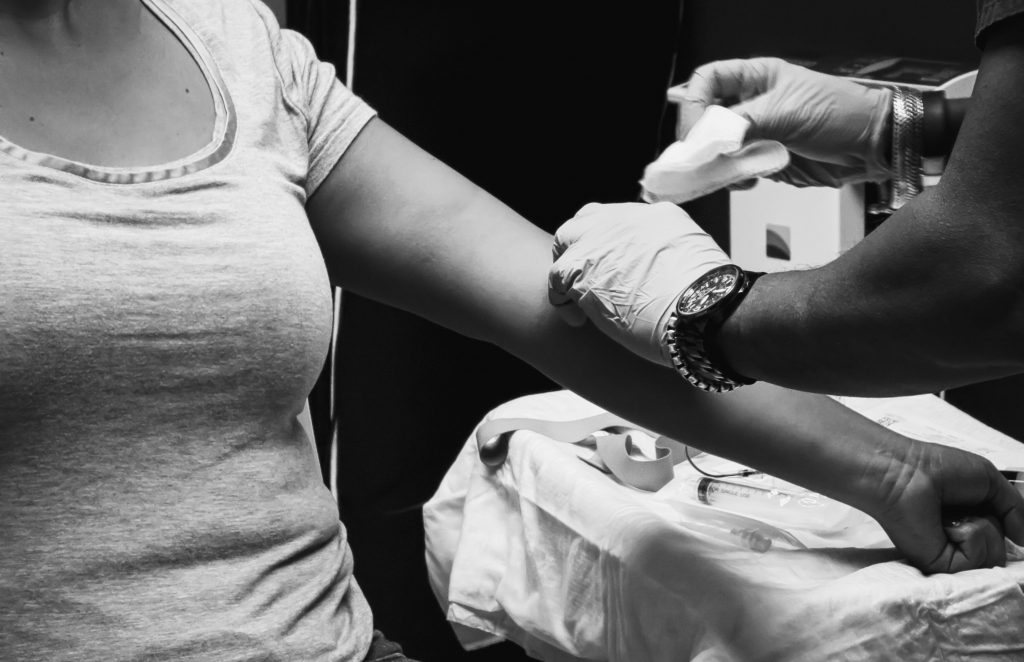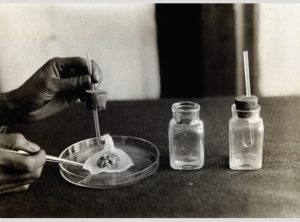Poliomyelitis is the name of the disease caused by the poliovirus, and it mostly affects children under the age of 5, causing paralysis in a small percent of cases. The disease had been around since the 1800s at low levels, but became an epidemic in multiple countries between the 1910s-1960s.
Because polio was killing and sickening children by the tens of thousands at its peak, scientists began an intense effort to develop a vaccine. Jonas Salk was credited with finally developing the first effective vaccine in 1953. However, hundreds of scientists were involved in the scientific work that led to this critical discovery. One of those scientists was John Enders.

John F. Enders, 1954. Source: Nobel Prize.org
The accepted understanding in the 1940s was that polio could only impact the nervous system, because of its paralysis symptoms. Enders and his team were among a subset of researchers who had been trying to demonstrate that the virus is able to grow in places in the body besides the nervous system. This would allow medical providers to understand if polio infection can also begin in places like the intestines, which some patient data had indirectly suggested.
To develop a vaccine against a virus, first you need to grow a lot of the virus to use in experiments. “Growing” a virus is not as simple as growing a plant or bacteria. Viruses don’t just grow by themselves. They need to infect living cells in order to reproduce. To produce viruses in the lab, a technique called mammalian tissue culture is used. Mammal cells aren’t free-living like bacteria. They are what make up the organs and body parts of mammals, like a rat or a human. So growing these cells in a dish is much more difficult. They need a lot of attention and a delicate balance of nutrients to grow for long periods of time.
Once you have mammal cells you can successfully grow in the lab, they are ready to be infected with the virus of interest. The virus then uses the cells to make more of itself. As Enders knew, the trouble with the poliovirus is that it was never shown to grow in any other cell type except for brain and nerve cells. Previous efforts by other scientists to grow the virus in liver, kidney, lung, and spleen cells had failed.
The image on the left (Source: NASA) shows what a tissue culture lab set-up looks like today, compared to the way it probably looked (on the right, Source: History of Vaccines) when Enders was doing his work in 1949.
Enders and his colleagues set out to grow the polio virus in human muscle, skin, connective tissue, and intestinal cells, compared to human brain cells. The cells they used for these experiments were taken from the bodies of deceased human embryos and one deceased premature infant. The initial virus sample was taken from an infected mouse brain. The researchers made sure it was the correct strain of the virus based on the type of disease it appeared to cause in the mice. To make sure they weren’t misdiagnosing the disease, they also neutralized the virus with an antibody that would only work on that strain. (Today you could also identify the virus by gene sequencing, but that didn’t exist yet!)
Borrowing a technique they used a year earlier to grow the mumps virus, Enders and his team suspended the human embryonic cells in a mixture of salt, buffers (to maintain the pH), and a protein-rich solution called ox serum ultrafiltrate to feed the cells. These cells were infected with the polio virus and allowed to grow in this mixture for 67 days. An equal number of non-infected cells were also grown as controls.
One thing the team did differently from previous attempts to grow the poliovirus was to change the nutrient solution out every 4-7 days. Cells will die in their own wastes if they are not provided with fresh nutrients on a regular basis. Additionally, every 8-20 days, they grew fresh “subcultures” from the original batch of cells, which is called passaging. It ensures that the cells are always actively dividing and healthy. Viruses need cells to be healthy and functioning, since a lot of the normal cell “machinery” is hijacked by the virus so it can make more of itself.
This video shows an animation of how the poliovirus infects people. Source: YouTube
Next, the team needed to figure out how much virus had been produced, using a technique called endpoint dilution. On the 16th day of the 67-day period, some of the infected fluids were taken from the muscle, skin, and connective tissue cultures and infected into mice and monkeys. Another set of mice and monkeys were infected with the original virus solution for comparison.
The amount of virus was estimated based on something called an LD50, which means “the dose that kills 50% of the infected animals after a specified time.” The volume of virus solution needed to kill 50% of the test animals was 1015 (10 trillion) times lower after 16 days compared to day 1, meaning it was more concentrated after 16 days. So, the virus had been successfully grown to very high levels. In the intestinal cells, that factor was 1014 and in the nerve cell controls it was 1012 .
These results were the first to demonstrate that the polio virus could be grown in skin, muscle, connective tissue, and intestinal cells to levels close to what could be grown in nerve cells. This breakthrough allowed Jonas Salk to grow large amounts of the polio virus in order to develop the world-changing vaccine. John Enders and his colleagues Robbins and Weller were awarded the Nobel Prize in Medicine in 1954 for this work.
For the lab nerds out there, here’s a bit of research history. Today there are much easier ways to count viruses that don’t require killing lab animals. Two of the most popular are called plaque assays (counting the number of holes in a layer of infected cells) and qPCR assays (counting the number of actual viruses using fluorescent dyes). The plaque assay was invented only 5 years after Enders’ work, and qPCR was not developed until 1993.
As for polio? The world has mostly rid itself of this devastating disease. The last known case in the US was in the late 1960s. There are still a few countries in the world who deal with it. Nigeria, Afghanistan, and Pakistan still have endemic polio, meaning it still infects people today.




